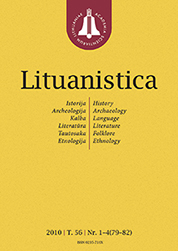LituanisticaWHAT?
 ISSN 0235-716X |
2004 m. Nr. 1 Poetinės kalbos ypatumai literatūroje ir kine
The article aims at revealing common peculiarities and differences of poetics of two artistic systems – fiction and cinema. On the basis of formalistic, structural and semiotic conceptions the possibilities of comparing these art structures are considered. Formalists emphasize that in an art text the main role is performed by the plane of form. In their opinion, poetics first of all should take interest into motivation of a sign, i.e. it should reveal the ways in which natural language becomes an art message, and at the same time separation of the signifier and the signified. Formalists consider “materija lity” of an art work to be a distinctive feature of sign systems, which indicates the most elementary structures of the meaning. Thus in fiction significance is attached to its verbas nature as well as to language figures such as sound system, rhythm, rhyme, tropes characterizing it.
From Russian formalism to Barthes’ theory of early structuralism, attention is drawn to the plane of expression of texts or art messages accepting appropriate universal systems or, in Jacobson’s terms, “synonymic structures” that arouse the effect of image analogy both in the grammatical system of the language and in visual arts. The specific character of poetical language holds a considerable place also in the school of semiotics. One of the main problems of comparing verbal and visual texts is the plane of representation, which is inseparable from the question of iconicity when discussing visual figures. In Greimas’ semiotics, iconicity is understood as a relation between two ways of “reality”, which is not arbitrary, but motivated. It should be stressed that in visual arts the perception of world features should be related to the act of imitation when natural characteristics of the world are transferred into the plane surface and are recognized as figures and not as objects. In principle, only visual features of the world are imitated. Contrary to Greimas, cinema semioticians emphasize the significance of the metalinguistic level defining a specific character of cinematographic codes. In this sense, the language of cinema is considered to be a specifically coded discourse. Special codes such as montage, moving of the camera, optical effects, etc. are characteristic only of the realm of cinematography and require special preparation and reading. That is their specific character on which relations among signs in the plane of a film depend. Thus the metalinguistic level of a text determines the boundaries of an art work that distinguish it from other texts and sign systems – natural language and art language, which is open to systematic as well as non-systematic (cultural) elements. |
Numeriai:
2011 - T.57 Nr.1, Nr.2, Nr.3, Nr.4 2010 - T.56 Nr.1-4 2009 - T.55 Nr.1-2, Nr.3-4 2008 - T.54 Nr.1, Nr.2, Nr.3, Nr.4 2007 - T.53 Nr.1, Nr.2, Nr.3, Nr.4 2006 Nr.1, Nr.2, Nr.3, Nr.4 2005 Nr.1, Nr.2, Nr.3, Nr.4 2004 Nr.1, Nr.2, Nr.3, Nr.4 2003 Nr.1, Nr.2, Nr.3, Nr.4 2002 Nr.1, Nr.2, Nr.3, Nr.4 2001 Nr.1, Nr.2, Nr.3, Nr.4 |